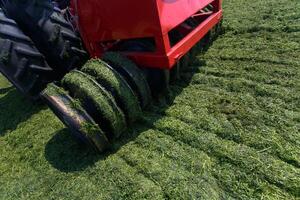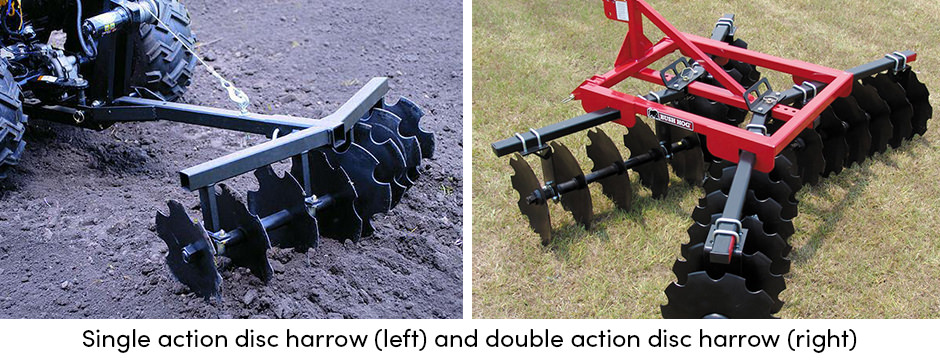Whether for large farms or small plots, soil preparation is a key step each planting season. Choosing the right tillage tool directly affects crop yield and the quality of the growing environment. The agricultural equipment market offers a wide range of options, but tools that balance efficiency and effectiveness are rare. The disc harrow stands out as one such tool; it’s easy to operate and significantly improves soil uniformity and suitability. Farmers widely rely on disc harrows for their unique design and powerful functions, making it easier to handle various tillage needs.
In agricultural tillage, the disc harrow plays multiple roles. It turns, cuts, and compacts the soil to reduce large clods, preventing soil surface hardening. For crop residue management, the disc harrow works efficiently to mix leftover crops into the soil, boosting nutrient content and balancing soil structure.
In this article, we’ll explore how to select, operate, and maintain a disc harrow so that you can more effectively meet the needs of different terrains and soil types and achieve high-quality soil preparation.

Contents
Functions and Roles of the Disc Harrow
The disc harrow plays an essential role in agricultural soil preparation. It cuts, turns, and compacts the soil, breaking up large clods and hardened surfaces. Farmers usually use it after deep or shallow plowing to get the land ready for further planting and seeding. Unlike traditional tillage methods, it spreads soil particles more evenly, promoting looseness and aeration in the soil structure. Additionally, it helps eliminate weeds and surface residues, mixing them into the soil to effectively enhance nutrients, creating a better environment for crop growth.
In modern agriculture, it goes beyond single-purpose tillage to become a versatile soil management tool. It not only increases soil granularity but also improves water absorption, preventing soil compaction during rainy seasons. For weed control and handling crop residue, the disc harrow performs efficiently. It quickly processes these materials, leaving a clean surface for the next planting phase. The working principle is straightforward. Rotating discs cut through the soil with ease. These discs are durable and concave, penetrating soil effectively and making them ideal for agricultural needs.
Disc Harrow: A Core Tool for Soil Preparation Management
The disc harrow is an agricultural tool designed to improve land by cutting and turning the soil. It includes concave steel disc blades mounted on a common axle, where each set of discs works together to cut, break clods, and penetrate surface crusts. The structure of a disc harrow consists of several key components:
- Frame: The frame fixes and supports the entire structure of the disc harrow.
- Discs: Typically made from steel with a concave shape, there are two common types:
- Smooth Edge Discs: Flat-edged discs suitable for regular soil conditions.
- Notched Edge Discs: Also known as cutting-edge discs, they feature serrated edges, making them more efficient for handling crop residue and weeds.
- Axle Bolts: These bolts secure each disc together, providing additional stability.
- Spacers or Bushings: These parts ensure that each disc remains in a fixed position, preventing lateral movement.
- Bearings: They support rotational movement and adjust thrust, enabling smooth disc harrow operation.
- Bumper: Located at the end of each disc set, the bumper prevents collisions between discs.
- Scrapers: These scrapers remove soil buildup on the discs, keeping the cutting surface clean and preventing clogging.
- Disc Sets: Each set usually includes 3 to 13 discs, complete with spacers, bearings, and bumpers.
- Weight Box: This component adds extra weight to the disc harrow, enhancing penetration into the soil.
Together, these parts allow the disc harrow to operate efficiently across a variety of soil conditions, making it a versatile and effective tool for soil management.
Types of Disc Harrows
Based on different operating methods and functions, disc harrows come in three main types:
- Single-Action Disc Harrow: Comprising two disc sets arranged in opposite directions, it throws soil outward to create ridges and furrows, making it suitable for smaller plots.
- Double-Action Disc Harrow: Also known as a tandem disc harrow, it arranges multiple harrow sets in a front-to-back layout, allowing it to handle larger areas with greater efficiency.

- Offset Disc Harrow: Featuring two disc sets placed in tandem, this harrow typically mounts on the right side of the tractor, making it ideal for challenging terrains.
Additionally, disc harrows can be further classified by the type of tractor mounting (mounted, semi-mounted, or trailed) and by disc diameter (light, medium, or heavy), allowing farmers to choose the best option for specific tillage needs.
How to Choose the Right Disc Harrow
Choosing the right type of it depends on its purpose and the size of the field. For larger plots, double-action or offset disc harrows provide higher efficiency, while smaller areas can be managed with a simpler single-action disc harrow. Additionally, based on soil characteristics and crop residue needs, farmers may opt for smooth-edge or notched-edge discs to suit various soil conditions and weed control requirements.
Applications of Disc Harrows in Soil Preparation
In soil preparation, the primary function of it is to break up and distribute soil evenly, creating an ideal base for planting. It effectively controls weeds, stabilizes soil structure, and enhances nutrient infiltration. A disk harrow with a weight box penetrates deeper, showing remarkable results on hard soil and in mixing residues.
Maintenance Tips for Disc Harrows
To ensure durability and peak performance, regular maintenance of the disk harrow is essential. Cleaning soil and debris from the disc blades, checking the tightness of bearings and bolts, and keeping the equipment well-lubricated all help prevent wear. Regularly replacing and inspecting scrapers avoids clogs and maintains cutting efficiency.
Conclusion
By making the right choice and performing proper maintenance, the disk harrow becomes an essential tool for efficient tillage and improved soil management. Understanding the functions, types, and selection guides allows farmers to pick the best disc harrow for their specific needs, enhancing farming efficiency and achieving optimal soil quality.Choose our disc harrows to boost tillage efficiency! We offer high-strength equipment suited for various soils, with models tailored to diverse requirements. Our effective weed-clearing and residue-mixing designs make tillage easier. Contact us for professional support and top results!

